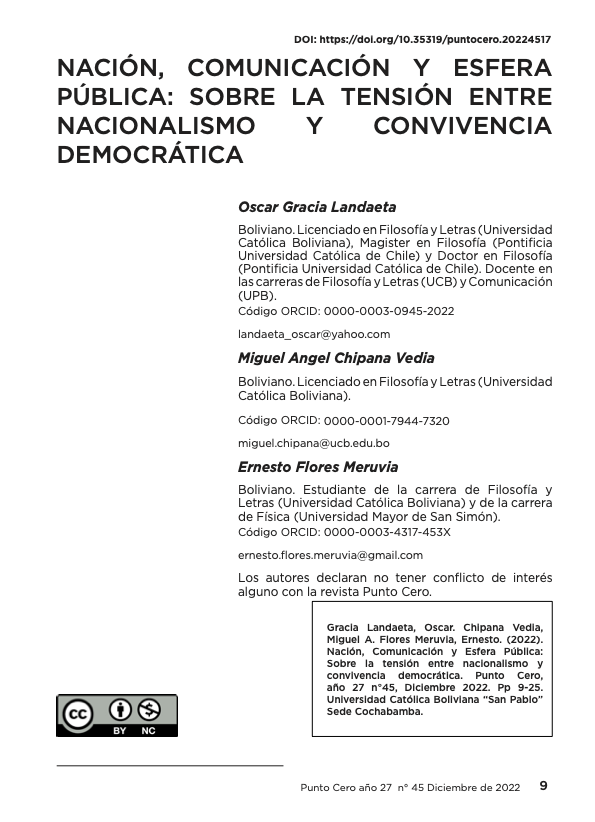Nation, communication and public sphere: on the tension between nationalism and democratic coexistence.
DOI:
https://doi.org/10.35319/puntocero.20224517Keywords:
Nation, Mass Media, Public Sphere, PluralityAbstract
This article considers the relations of tension that are established between the imaginaries and the discursive formations centered on the “nation”; and the conditions of diversity and plurality that should characterize the public sphere as a scenario for citizen debate and democratic coexistence. This relationship is considered through an analysis of the role of the mass media in the formation of both spheres (the national and the “public”) in modernity.
References
Anderson, Benedict (1993) Comunidades imaginadas. Reflexiones sobre el origen y la difusión del nacionalismo. México. Fondo de Cultura Económica.
Antonsich, M. y SKEY, M (Eds.) (2017). Everyday Nationhood. Theorizing Culture, Identity and Belonging after Banal Nationalism. London. Palgrave Macmillan.
Arendt, Hannah (1962). The Origins of Totalitarianism. Second Edition. New York. Meridian Books.
Arendt,Hannah(1998).TheHuman Condition. Chicago. University of Chicago Press.
Arendt, Hannah (2007). The Jewish Writings. New York. Schocken Books.
Bauer, Otto (2000). The Question of Nationalities and Social Democracy. Minneapolis. University of Minnesota Press.
Billing, Michael (1995). Banal Nationalism. London. Sage Publications.
Calhoun, Craig (1997). Nationalism. Minneapolis. University of Minnesota Press.
Calhoun, C. (1999). “Nationalism, Political Community and the Representation of Society. Or Why Feeling at Home is not a Substitute for Public Space” en European Journal of Social Theory, 2(2), pp. 217-231. DOI: https://doi.org/10.1177/13684319922224419
Calhoun, Craig (2017). “The Rhetoric of Nationalism”, en Everyday Nationhood. Theorizing Culture, Identity and Belonging after Banal Nationalism (M. Antonsich y M. Skey, Eds.). London. Palgrave Macmillan.
Esposito, Roberto (2003). Communitas. Origen y destino de la comunidad. Argentina. Amorrurtu Editores.
Esposito, Roberto (2006). Bíos. Biopolítica y filosofía. Argentina. Amorrurtu Editores.
Esposito, Roberto (2012). Diez pensamientos acerca de la política. México, D.F. Fondo de Cultura Económica.
Fraser, Nancy (1992). “Rethinking the Public Sphere: A Contribution to the Critique of Actually Existing Democracy”, en Habermas and the Public Sphere. Craig Calhoun (Ed.). Cambridge. The MIT Press.
Fuchs, Christian (2020). Nationalism on the Internet. New York. Routledge.
Giddens, Anthony (1994). Las consecuencias de la modernidad. Madrid. Alianza Editorial.
Habermas, Jürgen (1975). Perfiles filosófico-políticos. Madrid. Taurus Ediciones.
Habermas, Jürgen (1991). The Structural Transformation of the Public Sphere. An Inquiry into a Category of Bourgeois Society. Cambridge. The MIT Press.
Hernández, Carlos (2009). “‘Ponte la verde con el tri de mi corazón’: nacionalismo banal, televisión y futbol”, en Razón y palabra. Nro. 69.
Hilmes, Michelle (1997). Radio Voices. Minneapolis. University of Minnesota Press.
Lacey, K. (2002). “Radio in the Great Depression: Promotional Culture, Public Service and Propaganda”, en Radio Reader (Hilmes y Loviglio, Eds.). New York. Routledge.
Llandonosa, M. y VISA, M. (2020). “Nacionalismo banal/ nacionalismo cotidiano en la publicidad experiencial: los anuncios televisivos emitidos en Cataluña durante los años del proceso soberanista (2009- 2017)”, en Comunicación y sociedad = Communication & Society, vol. 33, núm. 2, p. 33-48.
Weintraub, Jeff (1997). “The Theory and Politics of the Public - Private Distinction”, en Public and Private in Thought and Practice. Perspectives on a Grand Dicothomy. Weintraub y Kumar (Eds.). Chicago. The University of Chicago Press.
Wolton, Dominique (1999). Sobre la comunicación. Una reflexión sobre sus luces y sus sombras. Madrid: Acento Editorial.

Downloads
Published
How to Cite
Issue
Section
License
Copyright (c) 2022 Revista Punto Cero

This work is licensed under a Creative Commons Attribution-NonCommercial 4.0 International License.








